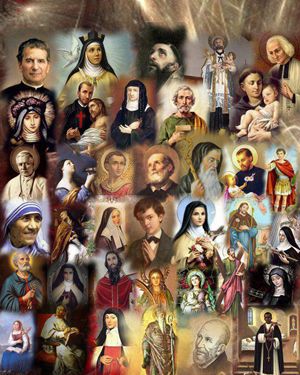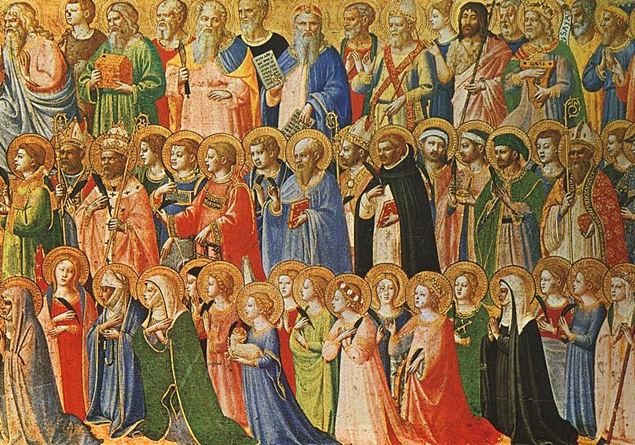The feast of All Saints (in the photo above, detail from the Fiesole Altarpiece by Fra Angelico) on November 1st spread throughout Latin Europe in the 8th-9th centuries. Then it began to be celebrated in Rome too, since the 9th century.
A single feast for all the Saints, that is, for the glorious Church, intimately united to the Church still pilgrimage and suffering on earth. All Saints’ Day is a celebration of hope: “the festive assembly of our brothers” represents the chosen and certainly successful part of the people of God; it calls us back to our goal and our true vocation: holiness, to which we are all called not through extraordinary works, but with the faithful fulfillment of the grace of baptism.
What is the meaning of this holiday?
To celebrate all the saints is to look upon those who already possess the inheritance of eternal glory. Those who wanted to live by their grace as adopted children, who let the Father’s mercy vivify every moment of their life, every fiber of their heart. The saints contemplate the face of God and fully rejoice in this vision. They are the older brothers that the Church offers us as models because, sinners like each of us, they have all agreed to let themselves be met by Jesus, through their desires, their weaknesses, their suffering, and even their sadness.
This bliss that sharing in this moment the very life of the Holy Trinity gives them is a fruit of superabundance that the blood of Christ has purchased for them. Despite the nights, through the constant purifications that love requires to be true love, and sometimes beyond all human hope, everyone wanted to let themselves be burned by love and disappear so that Jesus would progressively be all in them.
It is Mary, the Queen of all Saints, who tirelessly brought them back to this path of poverty; it is by following her that they learned to receive everything as a free gift from the Son; it is with her that they currently live, hidden in the secret of the Father.
What does the Roman Martyrology say?
With the Solemnity of all Saints united with Christ in glory in a single jubilant celebration, the Church still a pilgrim on earth venerates the memory of those in whose company heaven rejoices, to be incited by their example, cheered by their protection and crowned by their victory before the divine majesty for everlasting centuries.

What is the communion of saints?
“Our participation in the redemption of Christ,” he wrote Don Divo Barsotti, «it implies a participation in man in divine life, in a grace which however is not an exclusive good and never becomes so, but the more common it becomes, the more it participates. Now, precisely for this reason, the communion of holy things naturally and necessarily becomes the Communion of saints. If the grace of God is communicated to man only by opening man to a universal communion, it follows precisely that, the more man participates in these divine gifts, the more he also communicates with other men, he experiences a communion of love with all those who participate in the same goods. Through the charity of God, man does not open himself only to God, he does not enter into communion only with divinity, but he acquires his own transparency so that the soul can communicate with all other souls, he can also live a relationship of love with all his brothers and sisters.the. Sin has divided us, opposed us to each other and separated us, made us opaque, impenetrable to love; grace instead gives us this new transparency, it gives us this new possibility of communion of love. And this is precisely the effect of divine grace: that is, we live everyone’s life and everyone lives the same life as us; there is no longer anything that is one’s own that is not, here too, everyone’s. The richer we are and the more we share our goods with others, the more we live from the good of others. A saint is all the more holy the more he is devoid of any defense in his love, the less he is closed in his wealth.”
What does the Catechism of the Catholic Church say about the communion of saints?
The communion of saints is precisely the Church. Here’s what he says: «Since all believers form one body, the good of some is communicated to others. (…) In the same way we must believe that there is a communion of goods in the Church. But the most important member is Christ, for He is the Head. (…) Therefore, the good of Christ is communicated to all members; this happens through the sacraments of the Church.”
«The unity of the Spirit, by which the Church is animated and governed, ensures that everything it possesses is common to all those who belong to it».
The term “communion of saints” therefore has two meanings, closely linked: “communion with holy things (sancta) and “communion between holy people (sancti)”. «Holy of Holies!» – holy things to the saints – is proclaimed by the celebrant in most Eastern liturgies, at the moment of the elevation of the holy Gifts, before the distribution of Communion. The faithful (sancti) are nourished by the Body and Blood of Christ (sancta) to grow in the communion of the Holy Spirit and communicate it to the world.


